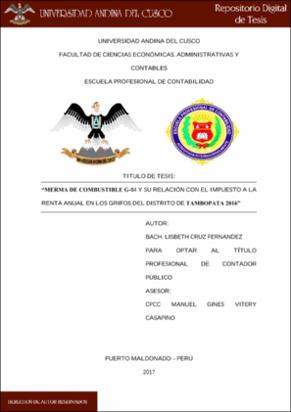| dc.contributor.advisor | Vitery Casapino, Manuel Gines | |
| dc.contributor.author | Cruz Fernandez, Lisbeth | |
| dc.date.accessioned | 2018-05-02T13:15:07Z | |
| dc.date.available | 2018-05-02T13:15:07Z | |
| dc.date.issued | 2017-12-21 | |
| dc.identifier.uri | https://hdl.handle.net/20.500.12557/1591 | |
| dc.description.abstract | El presente trabajo de investigación tiene como objetivo principal determinar en qué medida se relaciona la merma de combustible G-84 originadas en la operacionalización y el factor climatológico con el Impuesto a la Renta anual de los grifos del distrito de Tambopata en el año 2016. En su mayoría los grifos presentan este problema de merma que afectan y distorsionan sus estados financieros y su rentabilidad, por consiguiente, a este trabajo de investigación le respalda la debida literatura, normas legales y algunas opiniones de expertos en la materia de investigación. La población está conformada por 29 grifos del distrito de Tambopata y la muestra es la misma, se utilizó las encuestas las cuales fueron aplicadas a los administradores o encargados de cada grifo. Así mismo estas fueron ingresadas al SPSS 2.22 arrojando resultados óptimos. Nuestras conclusiones son en base a los objetivos e hipótesis planteados donde debíamos relacionar la variable merma de combustible G-84 y dimensiones con el Impuesto a la renta anual. De tal forma que también contrastamos con la realidad que se percibió en el momento. Las recomendaciones están relacionadas con nuestras conclusiones, como por
ejemplo se recomendó la protección del ambiente donde se almacena el combustible, capacitación al empleado que despacha el combustible y las formas de recepción. | es_PE |
| dc.description.abstract | The main objective of this research work is to determine the extent to which the G-84 fuel loss originated in the operationalization and the weather factor is related to the annual income tax of Tambopata district taps in 2016. In most cases the taps present this problem of shrinkage that affect and distort their financial statements and their profitability, therefore, this research work is supported by the appropriate literature, legal standards and some opinions of experts in the field of research. The population is made up of 29 taps from the district of Tambopata and the sample is the same, the surveys were used which were applied to the administrators or managers of each tap. Likewise, these were entered into the SPSS 2.22 yielding optimal results. Our conclusions are based on the objectives and hypotheses proposed where we had to relate the fuel depletion variable G-84 and dimensions with the annual income tax. In such a way that we also contrast with the reality that was perceived at the time. The recommendations are related to our conclusions, as for example the protection of the environment where the fuel is stored, training to the employee that dispenses the fuel and the forms of reception were recommended. | en_US |
| dc.description.uri | Tesis | es_PE |
| dc.format | application/pdf | es_PE |
| dc.language.iso | spa | es_PE |
| dc.publisher | Universidad Andina del Cusco | es_PE |
| dc.rights | info:eu-repo/semantics/openAccess | es_PE |
| dc.rights.uri | https://creativecommons.org/licenses/by-nc-nd/2.5/pe/ | es_PE |
| dc.source | Universidad Andina del Cusco | es_PE |
| dc.source | Repositorio Institucional - UAC | es_PE |
| dc.subject | Merma combustible | es_PE |
| dc.subject | Impuesto a la renta | es_PE |
| dc.subject | Rentabilidad | es_PE |
| dc.subject | Tambopata | es_PE |
| dc.title | Merma de combustible G-84 y su relación con el impuesto a la renta anual en los grifos del distrito de Tambopata 2016. | es_PE |
| dc.type | info:eu-repo/semantics/bachelorThesis | es_PE |
| thesis.degree.name | Contador Público | es_PE |
| thesis.degree.grantor | Universidad Andina del Cusco. Facultad de Ciencias Económicas, Administrativas y Contables | es_PE |
| thesis.degree.level | Titulo Profesional | es_PE |
| thesis.degree.discipline | Contabilidad | es_PE |


